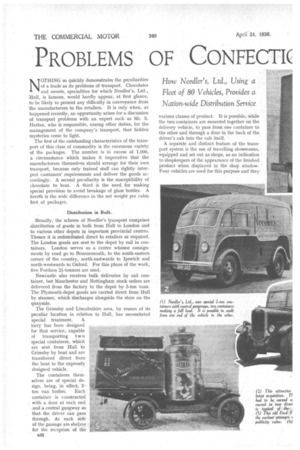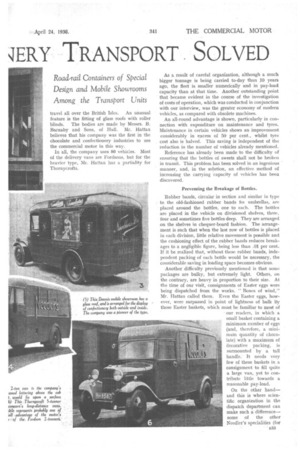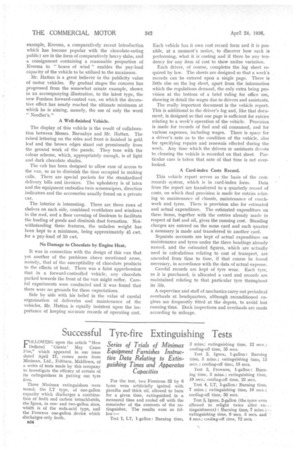PROBLEMS OF CONFECTK
Page 46

Page 47

Page 48

If you've noticed an error in this article please click here to report it so we can fix it.
gERY TRANSPORT SOLVED N°THING so quickly demonstrates the peculiarities of a trade as its problems of transport. Chocolates and sweets, specialities for which Needier's, Ltd., Hull, is famous, would hardly appear, at first glance, to be likely to present any difficulty in conveyance from the manufacturers to the retailers. It is only when, as happened recently, an opportunity arises for a discussion of transport problems with an expert such as Mr. S. Hattan, who is responsible, among other duties, for the management of the company's transport, that hidden mysteries come to light.
The first of the outstanding characteristics of the transport of this class of commodity is the enormous variety of the packages. The number is in excess of 1,000. a circumstance which makes it imperative that the manufacturers themselves, should arrange for their own transport, because only trained staff can rightly interpret customers' requirements and deliver the goods accordingly. A second peculiarity is the susceptibility of chocolate to heat. A third is the need for making special provision to avoid breakage of glass bottles. A fourth is the wide difference in the net weight per cubic foot of packages.
Distribution in Bulk.
Broadly, the scheme of Needler's transport comprises distribution of goods in bulk from Hull to London and to various other depots in important provincial centres. Thence it is redistributed direct to retailers as required. The London goods are sent to the depot by rail in containers. London serves as a centre whence consignments by road go to Bournemouth, to the south-eastern corner of the country, north-eastwards to Ipswich and north-westwards to Oxford. For this phase of the work, five Fordson 2i-tonners are used.
Newcastle also receives bulk deliveries by rail container, but Manchester and Nottingham stock orders are delivered from the factory to the depot by 5-ton vans. The Plymouth-depot goods are carried direct from Hull by steamer, which discharges alongside the store on the quayside.
The Grimsby and Lincolnshire area, by reason of its peculiar location in relation to Hull, has necessitated
special -Li eatment. A
Lorry has been designed for that service, capable of transporting two special containers, which are sent from Hull to Grimsby by boat and are transferred direct from the boat to the expressly designed vehicle.
The containers themselves are of special design, being, in effect, 2ton van bodies. Each container is constructed with a door at each end and a central gangway so that the driver can pass; through. At each side of the passage are shelves for the reception of the 832 various classes of product. It is possible, while the two containers are mounted together on the delivery vehicle, to pass from one container to the other and through a door in the back of the driver's cab into the cab itself.
A separate and distinct feature of the transport system is the use of travelling showrooms, equipped and set out as shops, as an indication to shopkeepers of the appearance of the finished product when displayed in the shop window. Four vehicles are used for this purpose and they travel all over the British Isles. An unusual feature is the fitting of glass roofs with roller blinds. The bodies are made by Messrs. B. Barnaby and Sons, of Hull. Mr. Hattan believes that his company was the first in the chocolate and confectionery industries to use the commercial motor in this way.
In all, the company uses 80 vehicles. Most of the delivery vans are Fordsons, but for the heavier type, Mr. Hattan has a partiality for Thornycrofts.
As a result of careful organization, although a much bigger tonnage is being carried to-day than 10 years ago, the fleet is smaller numerically and in pay-load capacity than at that time. Another outstanding point that became evident in the course of the investigation of costs. of operation, which was conducted in conjunction with our interview, was the greater economy of modern vehicles, as compared with obsolete machines.
An all-round advantage is shown, particularly in connection with expenditure on maintenance and tyres. Maintenance in certain vehicles shows an improvement considerably in excess of 50 per cent., whilst tyre cost also is halved. This saving is independent of the reduction in the number of vehicles already mentioned.
Reference has already been made to the difficulty of ensuring that the bottles of sweets shall not be broken in transit. This problem has been solved in an ingenious manner, and, in the solution, an effective method of increasing the carrying capacity of vehicles has been discovered.
Preventing the Breakage of Bottles.
Rubber bands, circular in section and similar in type to the old-fashioned rubber bands fin umbrellas, are placed around the bottles, one to each. The bottles are placed in the vehicle on divisioned shelves, three, four and sometimes five battles deep. They are arranged on the shelves in chequer-board fashion. The arrangement is such that when the last row of bottles is placed in each division, little relative movement is possible and the cushioning effect of the rubber bands reduces breakages to a negligible figure, being less than .01 per cent. If it be realized that, without these rubber bands, independent packing of each bottle would be necessary, the considerable saving in loading space becomes obvious.
Another difficulty previously mentioned is that some packages are bulky, but extremely light. Others, on the contrary, are heavy in proportion to their size. At the time of our visit, consignments of Easter eggs were being dispatched from the works. " Boxes of wind," Mr. Hattan called them. Even the Easter eggs, however, were surpassed in point of lightness of bulk by those Easter baskets, which must be familiar to most of our readers, in which a small basket containing a minimum number of eggs (and, therefore, a minimum n quantity of chocolate) with a maximum of decorative packing, is surmounted by a tall handle. It needs very few of these baskets in a consignment to fill quite a large van, yet to contribute little towards a reasonable pay-load.
On the other hand— and this is where scientific organization in the dispatch department can make such a difference— some of the other Needler'S specialities (for example, Kreema, a comparatively recent introduction which has become popular with the chocolate-eating public) are in the form of comparatively heavy slabs, and a consignment containing a reasonable proportion of Kreema to "boxes of wind" enables the pay-load capacity of the vehicle to be utilized to the maximum.
Mr. Hattan is a great believer inthe publicity value of motor vehicles. By gradual stages the concern has progressed from the somewhat ornate example, shown in an accompanying illustration, to the latest type, the new Fordson forward-control van, on which the decorative effect has nearly reached the ultimate minimum at which he is aiming, namely, the use of only the word " Needier's."
A Well-finished Vehicle.
The display of this vehicle is the result of collaboration between Messrs. Barnabys and Mr. Hattan. The raised lettering on the sides and front is finished in gold leaf and the brown edges stand out prominently from the ground work of the panels. They tone with the colour scheme, which, appropriately enough, is of light and dark chocolate shades.
The cab has been designed to allow ease of access to the van, so as to diminish the time occupied in making calls. There are special pockets for the standardized delivery bills and invoices. The upholstery is of latex and the equipment embodies twin screenwipers, direction indicators and the accessories usually found on a private car.
The interior is interesting. There are three rows of shelves on each side, combined ventilators and windows in the roof, and a floor covering of linoleum to facilitate the loading of goods and diminish dust formation. Notwithstanding these features, the unladen weight has been kept to a minimum, being approximately 45 cwt. for a pay-load of 50 cwt.
No Damage to Chocolate by Engine Heat.
It was in connection with the design of this van that yet another of the problems above mentioned arose, namely, that of the susceptibility of chocolate products to the effects of heat. There was a faint apprehension that in a forward-controlled vehicle, any chocolate packed towards the front of the van might suffer. Careful experiments were conducted and it was found that there were no grounds for these expectations.
Side by side with his belief in the value of careful organization of deliveries arid maintenance of the -vehicles, Mr. }rattan is equally insistent upon the importance of keeping accurate records of operating cost. Each vehicle has it own cost record form and it is possible, at a moment's notice, to discover how each is performing, what it is costing and if there be any tendency for any item of cost to show undue variation.
Each driver, of course, completes the log sheet required by law. The sheets are designed so that a week's records can be entered upon a single page. There is little else on the log sheet, apart from the information which the regulations demand, the only extra being provision at the bottom of a brief ruling for office use, showing in detail the wages due to drivers and assistants.
The really important document is the vehicle report. This is additional to the driver's log and, like that dotumeat, is designed so that one page is sufficient for entries relating to a week's operation of the vehicle. Provision is made for records of fuel and oil consumed, and for various expenses, including wages. There is space for a driver's note as to the condition of the vehicle, also for specifying repairs and renewals effected during the week. Any time which the drivers or assistants devote to cleaning the vehicle is recorded on that sheet. Particular care is taken that note of that time is not overlooked.
A Card-index Costs Record.
This vehicle report serves as the basis of the cost
records system, which is in card-index form. Data from the report are transferred to a quarterly record of costs, on which dual provision is made for entries relating to maintenance of chassis, maintenance of coachwork and tyres. There is provision also for estimated and actual expenditure. The estimated expenditure on these items, together with the entries already made in respect of fuel and oil, gives the running cost. Standing charges are entered on the same card and each quarter a summary is made and transferred to another card.
Separate accounts are kept of actual expenditure on maintenance and tyres under the three headings already named, and the estimated figures, which are actually used in calculations relating to cost of transport, are amended from time to time, if that course be found necessary, in accordance with the data of actual expense.
Careful records are kept of tyre wear. Each tyre, as it is purchased, is allocated a card and records are maintained relating to that particular tyre throughout its life.
A supervisor and staff of mechanics carry out periodical overhauls at headquarters, although reconditioned engines are frequently fitted at the depots, to avoid lost running time. Dock inspections and overhauls are made according to mileage.




























































































